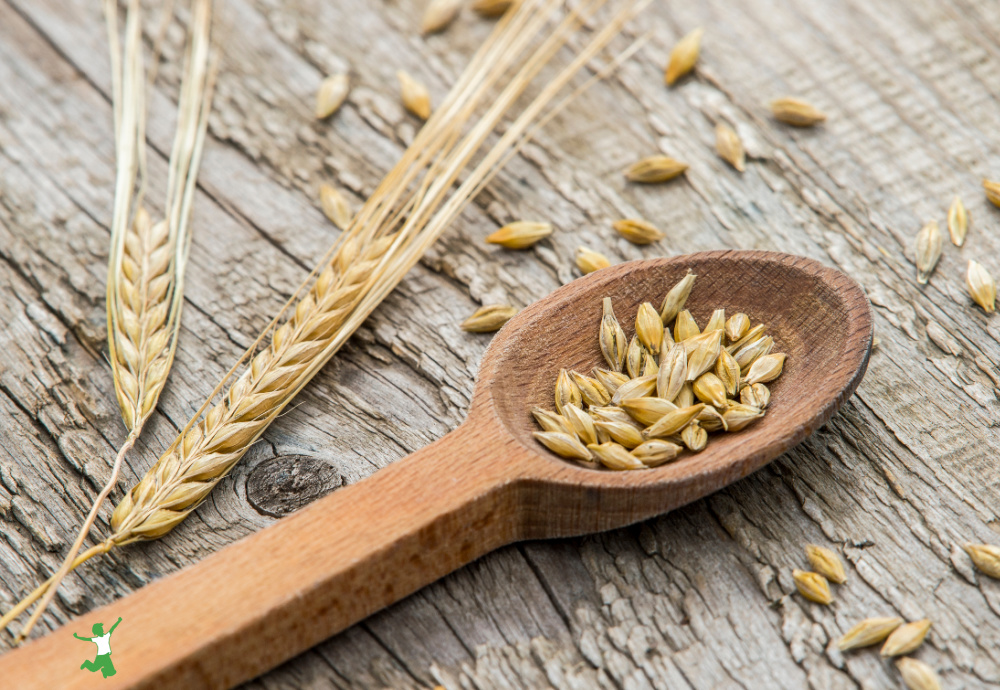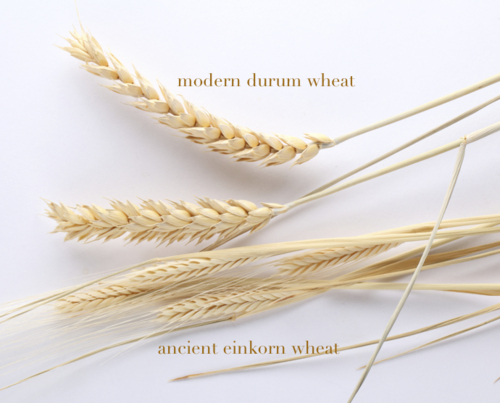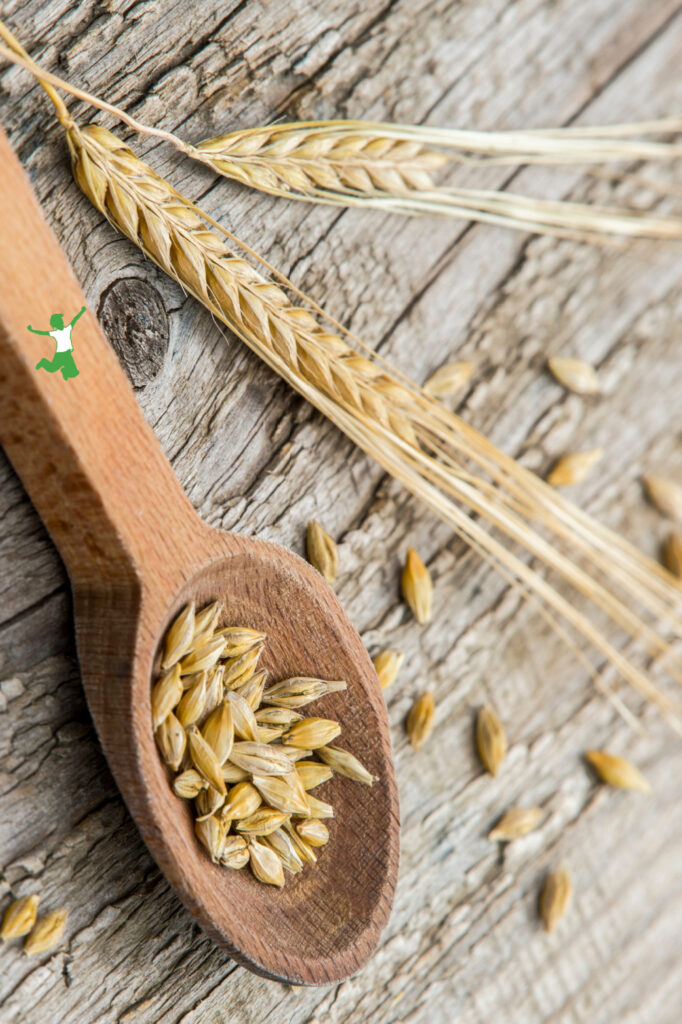There are four big reasons why einkorn is, by far, the best form of wheat to eat even when compared to other ancient grains like spelt, emmer, and kamut.

Most people who love to bake bread, pastries, and other goodies do not realize that einkorn is the best type of wheat to use.
Twenty-five or so years ago, I used to purchase organic white wheat (hard and soft) and spelt in bulk from a local grain co-op for my baking endeavors.
Grinding grain into fresh flour is certainly the most nutritious and tastiest way to bake! I also did this to avoid the conventional toxic wheat desiccated with gut-destroying glyphosate.
Caveat: Baking with freshly ground flour is only better if the bread is traditionally prepared.
Otherwise, the antinutrients like phytic acid are not broken down and harm to gut health is likely over time.
There certainly is a huge difference between modern processed wheat (hybridized by irradiation) and the organic, ancient grains you grind yourself at home.
I remember when I was breastfeeding my youngest child, if I ate so much as a mouthful or two of processed wheat at a restaurant, she would spit up for one or sometimes even two days!
If I ate organic wheat that I ground myself and either sprouted, soaked, or sour-leavened (sourdough), however, she never had any spit-up issues.
To me, this was a huge testament to the radically improved digestibility of wheat that is prepared using the wise methods of ancestral cultures.
Beware of persuasive influencers who claim that all you need to do is grind freshly ground flour and bake bread with baker’s yeast with no proper preparation such as soaking, sprouting or sour-leaving the dough necessary.
This approach is not how traditional societies ever baked their bread, and it is a recipe for serious gut issues!
Most people do not know that baker’s yeast is actually a modern invention only used in the past few centuries!
It quickly gained traction because it made baking faster and easier (NOT healthier). This is the case even when using freshly ground flour!
These quick rise breads using baker’s yeast gradually displaced traditional sourdough to the detriment of those who embraced this early “modern” cooking convenience.
Einkorn Benefits over Modern Wheat
With traditional baking the way to go (using a sourdough starter and NOT baker’s yeast), let’s talk about einkorn as the best type of wheat to bake with.
There are four reasons why I prefer to bake with einkorn wheat and no other type of ancient grains.
This isn’t to say I never use anything else, but if given the choice, I prefer to use einkorn.
Note that einkorn is not to be confused with farro or heirloom wheat.
Better Taste
My first experience baking with einkorn occurred after I received a thoughtful gift of, among other things, einkorn flour and wheat berries. I was delighted when I ground the einkorn into flour and saw how light and white it was.
I am not a fan of bran and am not of the food philosophy that all that fiber is actually good for your gut.
Fiber is a band-aid that covers up the root causes of constipation, a very common symptom of gut imbalance.
I recommend the book Fiber Menance as a good read on the subject.
The truth is that the unhybridized form of wheat…einkorn is the only one…does not have that much bran!
I was thrilled to see that my family thoroughly enjoyed the soaked waffles made with freshly ground einkorn flour.
Later on, I learned to make sprouted einkorn waffles that were more convenient but still highly digestible.
From that point, I gradually incorporated using einkorn for all my baking needs including this very popular no knead sourdough bread recipe.
Most Digestible
Because einkorn is unhybridized and low in bran, it is the most digestible form of wheat you can eat.
While my properly prepared grain dishes made with white wheat or spelt digest fine for our family, you can tell that the same dishes make with einkorn feel even better in the stomach.
This is possibly because einkorn contains good gluten, different on a molecular level from modern gluten in all other forms of wheat including ancient grains like spelt.
Better digestion means better absorption of nutrients, so einkorn surpasses the competition in that category as well.
Visually Distinctive

The first thing I noticed when I ground einkorn into flour for the first time was how much smaller a grain of einkorn is compared with a grain of modern wheat. They are about half the size!
In addition, I noticed that my grain grinder makes less noise when grinding einkorn berries into fresh flour because of softer, low bran kernels.
The distinctive crease on one side of a grain of modern wheat is also absent from kernels of einkorn.
The reason for the differences is that over the centuries, the genetics of wheat gradually changed due to human cultivation practices.
Year after year, farmers selected the seeds at harvest time that suited the goal of higher yields and MORE gluten.
This worked best for big farms and larger-scale agriculture, production, and distribution of wheat products.
The ONLY Unhybridized Wheat

Einkorn is like most plants in that it is diploid.
This means that einkorn contains only 2 sets of chromosomes.
About 2,000 years after einkorn wheat, nature created emmer via the natural hybridization of 2 wild grasses.
Consequently, emmer has 4 sets of chromosomes. Kamut and durum (bulgur) wheat are both descendants of emmer.
Spelt, an heirloom wheat, is the result of hybridization between cultivated emmer and another wild grass. Thus, spelt contains six sets of chromosomes.
Modern wheat is a descendant of spelt.
As you can see, einkorn is the purest and most ancient form of wheat available. With only 2 sets of chromosomes, a very different composition of gluten, and low bran, it is the most digestible form of wheat for baking at home.
Where to Source Quality Einkorn
The only downside of einkorn is that it is not widely available and tends to be more expensive than other types of wheat. It is still quite new to the North American market.
If you are sourcing organic einkorn berries, I recommend this quality brand.
If you need organic sprouted einkorn berries for more convenient baking, this farm based in the United States is my preferred source.
Have you tried einkorn wheat yet? If so, what observations have you made about this ancient, unhybridized wheat?









I am trying to sprout my einkorn berries I received from Azure. It’s been 4 days – and nothing. Does anyone have any suggestions?
I have a nutrimill. Reply if you are interested.
FYI:
Hi, What kind of grain grinder do you use? And do you have a link to buy one? Thanks! I ordered some Einkorn and am excited!!
I have a nutrimill. Reply if you are interested.
SPROUTING EINKORN – If you try to sprout einkorn grains, and they do not grow, but become mushy – you have dead, old seeds. No life in them. Procure fresh living einkorn seeds from a local farmer!
RED FIFE is a delicious facultative heritage wheat known as Halychanka in Galicia in its region of origin. The Heritage Grain Conservancy offers many more delicious heritage landrace wheats from Europe and the Mideast. They are easy to grow, higher in nutrition and lower in gluten than modern hybrid wheat.
https://sites.google.com/site/loisellema/linkssourcesinfo/hypoallergenic-red-fife
I found this article concerning Red Fife
Compare it to itself! Experiment for yourself! Try baking with einkorn flour to discover for yourself the taste, low-gluten baking quality and nutritional value . I grow many acres of diverse varieties of ancient einkorns that I collected from France, Italy, Germany, Bulgaria, Israel and more. Each has a unique quality. I even crossed the healthiest with the healthiest plants, to create a new local landrace that is well-adapted to New England. There are many more almost-lost ancient grain species that the heritage Grain Conservancy is restoring, esp from the Caucasus Mountains. Eli Rogosa, Heritage Grain Conservancy
Eli..what do you think about Red Fife. It is the only grain I can find up here in Canada. This farmer started growing it a few years back. It is suppose to be really good for people who need to eat gluten free. I find I am still reacting to it though.
https://sites.google.com/site/loisellema/linkssourcesinfo/hypoallergenic-red-fife
Jovial’s Einkorn flour is sifted. Isn’t that the same as the white flour on the grocery store shelves today? All the bran, germ, vitamins and minerals are removed after sifting. That is why we mill our own flour to consume immediately. Also, was wheat soaked in biblical days before making into bread? I am not sure of the purpose of this step before making bread, cookies, etc. Has anyone watched the videos on the BreadBeckers website? http://www.breadbeckers.com They are the reason I started milling my own flour. If anyone knows anything about wheat and milling your own, they sure do! Not once have I seen or heard anything from their recipes or website stating that you need to soak wheat before milling. I am confused!
Einkorn (T. monococcum) is NOT wheat. It has no genetic relationship to T. dicoccoides (wild wheat). Bill Davis is incorrect in grouping einkorn with wheat. Although monococcum is classified within the Triticum tribe, it evolved from wild einkorn – not wild wheat!
from Eli Rogosa, Heritage Grain Conservancy
so if einkorn is not wheat, what is it? What can we compare it to?
Author of wheat belly recommends to stay away from all types of wheat